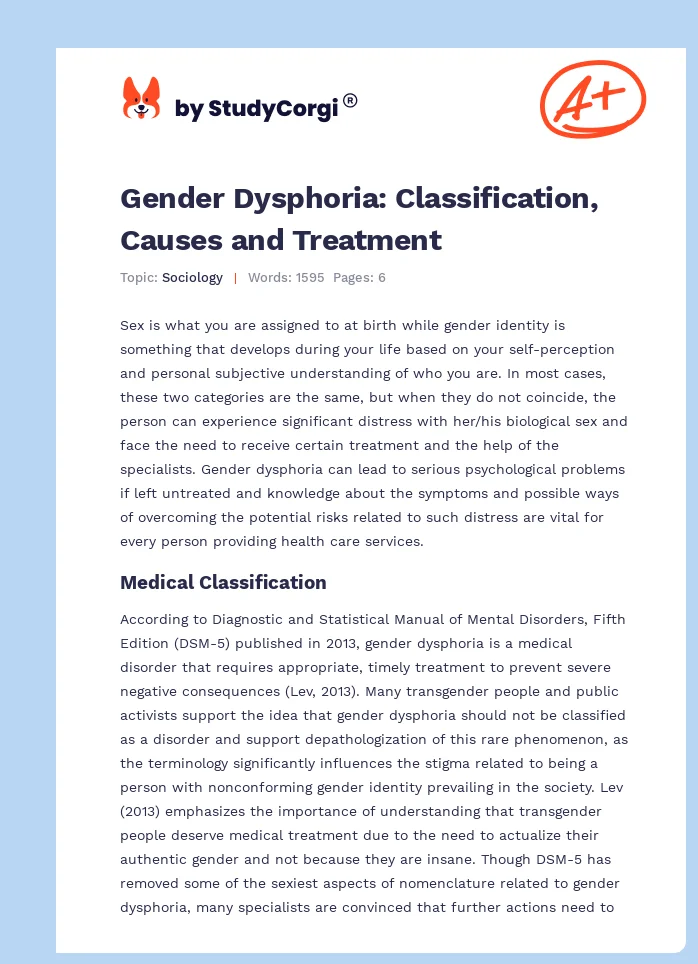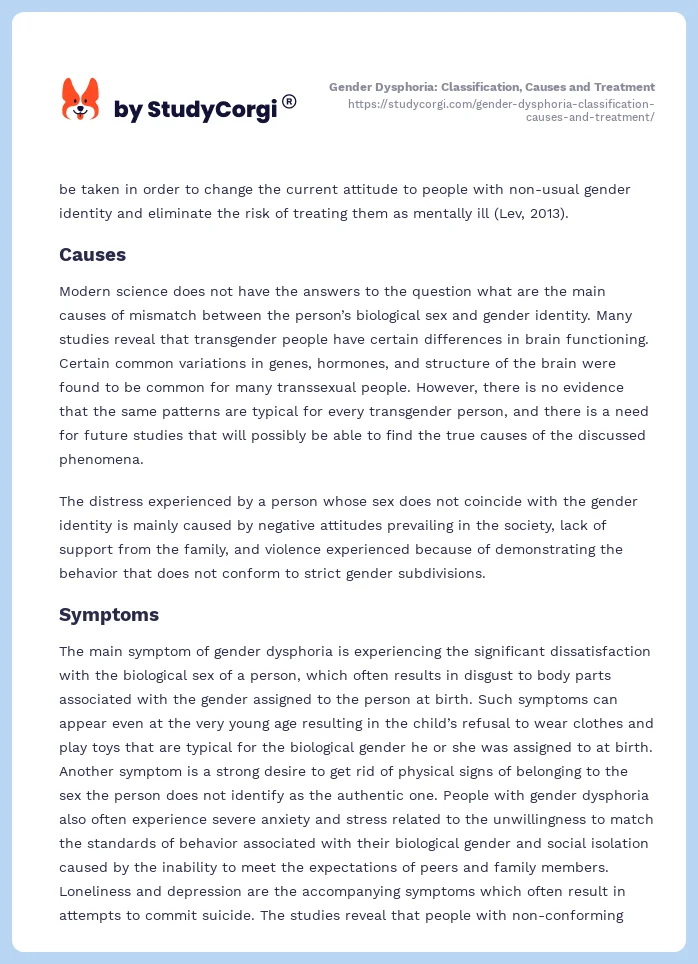

Table of Contents
Sex is what you are assigned to at birth while gender identity is something that develops during your life based on your self-perception and personal subjective understanding of who you are. In most cases, these two categories are the same, but when they do not coincide, the person can experience significant distress with her/his biological sex and face the need to receive certain treatment and the help of the specialists. Gender dysphoria can lead to serious psychological problems if left untreated and knowledge about the symptoms and possible ways of overcoming the potential risks related to such distress are vital for every person providing health care services.
Medical Classification
According to Diagnostic and Statistical Manual of Mental Disorders, Fifth Edition (DSM-5) published in 2013, gender dysphoria is a medical disorder that requires appropriate, timely treatment to prevent severe negative consequences (Lev, 2013). Many transgender people and public activists support the idea that gender dysphoria should not be classified as a disorder and support depathologization of this rare phenomenon, as the terminology significantly influences the stigma related to being a person with nonconforming gender identity prevailing in the society. Lev (2013) emphasizes the importance of understanding that transgender people deserve medical treatment due to the need to actualize their authentic gender and not because they are insane. Though DSM-5 has removed some of the sexiest aspects of nomenclature related to gender dysphoria, many specialists are convinced that further actions need to be taken in order to change the current attitude to people with non-usual gender identity and eliminate the risk of treating them as mentally ill (Lev, 2013).
Causes
Modern science does not have the answers to the question what are the main causes of mismatch between the person’s biological sex and gender identity. Many studies reveal that transgender people have certain differences in brain functioning. Certain common variations in genes, hormones, and structure of the brain were found to be common for many transsexual people. However, there is no evidence that the same patterns are typical for every transgender person, and there is a need for future studies that will possibly be able to find the true causes of the discussed phenomena.
The distress experienced by a person whose sex does not coincide with the gender identity is mainly caused by negative attitudes prevailing in the society, lack of support from the family, and violence experienced because of demonstrating the behavior that does not conform to strict gender subdivisions.
Symptoms
The main symptom of gender dysphoria is experiencing the significant dissatisfaction with the biological sex of a person, which often results in disgust to body parts associated with the gender assigned to the person at birth. Such symptoms can appear even at the very young age resulting in the child’s refusal to wear clothes and play toys that are typical for the biological gender he or she was assigned to at birth. Another symptom is a strong desire to get rid of physical signs of belonging to the sex the person does not identify as the authentic one. People with gender dysphoria also often experience severe anxiety and stress related to the unwillingness to match the standards of behavior associated with their biological gender and social isolation caused by the inability to meet the expectations of peers and family members. Loneliness and depression are the accompanying symptoms which often result in attempts to commit suicide. The studies reveal that people with non-conforming gender identity are at very high risk of suicidal behavior, as nearly 41% of American citizens experiencing gender dysphoria were found to have attempts to end their lives (Grant et al., 2011). The risk of trying to commit suicide significantly rises in the cases when transgender people experience violence and are not supported by their families (Reyes, 2014).
Diagnosis
Diagnosis of gender dysphoria can be carried by specialists working in Gender Identity Clinic after conducting the corresponding in-depth assessment of the specifics of a person’s attitude to the biological sex, the typical behavioral patterns, the ability to cope with the difficulties related to the experienced mismatch, physical and psychological health, and other factors. The diagnosis of gender dysphoria can be carried after the specialist gathers the information revealing if the person experiences two or more of the criteria for gender distress mentioned in DSM-5 for at least six months. After the diagnosis is confirmed, the corresponding treatment plan aimed at offering appropriate psychological help is developed, and the potential steps related to medical or surgical treatment are discussed.
The age at which gender dysphoria can be diagnosed is a highly controversial issue attracting much attention of various specialists whose debates are centered on the long-term effects of early interventions and potential negative consequences of delayed treatment. The question is how to determine the age when the child’s refusal to conform to the typical behavior rules of his/her biological sex is no longer a temporary pattern typical for many children but a serious predictor of gender dysphoria. For example, many little girls prefer playing boyish toys, but most of them do not become transgender. Therefore carrying assessment at the very young age can potentially influence the subsequent development of a person and mistakenly diagnose a person with temporary childish preferences with gender distress. Most specialists agree that the most optimal age for diagnosing gender dysphoria in children is around ten years (Nicholson & McGuinness, 2014). However, if the person experiences significant difficulties with social functioning, strong dislike of existing sexual anatomy, etc., then the specialists can conduct appropriate assessments able to confirm that the child is transgender at the earlier age as the delay in providing treatment for such children can lead to serious negative consequences, including long-term depression and attempts to commit suicide (Nicholson & McGuinness, 2014). Further research is needed to define the age that is optimal for diagnosing gender dysphoria and providing the appropriate treatment.
Treatment
The treatment of gender dysphoria is mainly aimed at eliminating emotional distress and supporting the person’s ability to demonstrate his/her gender identity; psychological assistance, hormone therapy, and surgery are the most common types of treatment provided to people experiencing gender dysphoria.
Psychological help is one of the main keys to helping the person experiencing stress because of the mismatch between his/her biological sex and gender identity. Psychological counseling is aimed at assisting the person in the process of getting rid of the feeling of guilt related to the inability to meet the expectations of society or family. Psychologists help transgender people to accept their personalities and learn how to express their gender identity in the way that make them feel happy and full-fledged members of society. Psychological treatment often includes counseling provided for the relatives of the transgender person aimed at eliminating the causes of conflicts.
Hormone therapy is based on taking the medications that suppress the release of hormones typical for the sex assigned to birth and stimulate the production of hormones typical for the gender identified by the person as the authentic one. Such treatment is highly controversial as it causes irreversible changes in the organism and eliminates the possibility of returning to the initial biological sex. The age at which hormone therapy can be given to children experiencing gender dysphoria is also a theme of numerous debates. While the decision whether to give hormones to an adolescent or not depends on the parents, some specialists prescribe puberty blocker hormones to children with gender distress to enable them to make a decision on hormonal gender reassignment by themselves at the older age.
Surgical treatment includes genital surgery, breast surgery, laser hair removal, and other interventions aimed at changing the physical appearance of the person in such way that it corresponds to the authentic gender. Surgical treatment appears to be a rather effective method of treatment of gender distress, as most studies reveal that transgender people that have received such treatment experience significant improvements in emotional stability, satisfaction with life, and overall happiness (Gijs & Brewaeys, 2007). Moreover, the studies show that there is a very small percent of those who regret surgical sex reassignment, and in most cases such treatment has obvious positive results (Gijs & Brewaeys, 2007). However, the age at which the decision about receiving surgical treatment of gender dysphoria can be made is also a controversial issue, as the consequences of such surgeries are irreversible and cause serious biological changes in the body of a person.
Conclusion
The attitudes to non-conforming gender identity have changed significantly during the last century. Modern medicine is not aimed at making a person who identifies her/his gender as opposite to the biological sex conform to the common gender division standards. Instead, modern health care tries to help transgender people live the life free of regrets and stress and adjust their life to the identity they have. While the causes of such phenomenon are still unclear, its consequences are rather well defined, and gender dysphoria is one of them.
The distress experienced by people with non-conforming gender identity can lead to serious negative consequences, including depression, attempts to commit suicide, social isolation, etc. That is why timely diagnosing and treatment is the key to eliminating the risks faced by transgender people demonstrating the symptoms of dysphoria. However, the definite age suitable for starting diagnosing and providing hormone and surgery therapy remains a controversial issue.
Every person involved in providing health care services needs to have the essential knowledge about gender dysphoria, as its timely identification is the key to assisting the person in overcoming the experienced difficulties and choosing the most appropriate methods of treatment.
References
Gijs, L., & Brewaeys, A. (2007). Surgical treatment of gender dysphoria in adults and adolescents: Recent developments, effectiveness, and challenges. Annual Review of Sex Research, 18, 178-224.
Grant, J., Mottet, L., Tanis, J., Harrison, J., Herman, J., & Keisling, M. (2011). Injustice at every turn: A report of the national transgender discrimination survey. Web.
Lev, A. (2013). Gender dysphoria: Two steps forward, one step back. Clinical Social Work Journal, 41(3), 288-296.
Nicholson, C., & McGuinness, T. (2014). Gender dysphoria and children. Journal of Psychosocial Nursing & Mental Health Services, 52(8), 27-30.
Reyes, A. (2014). Transgender study looks at ‘exceptionally high’ suicide-attempt rate. Web.






































